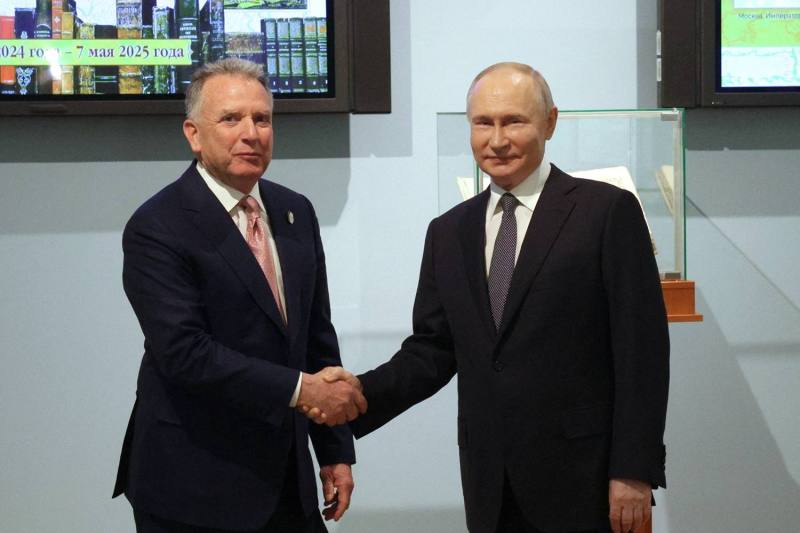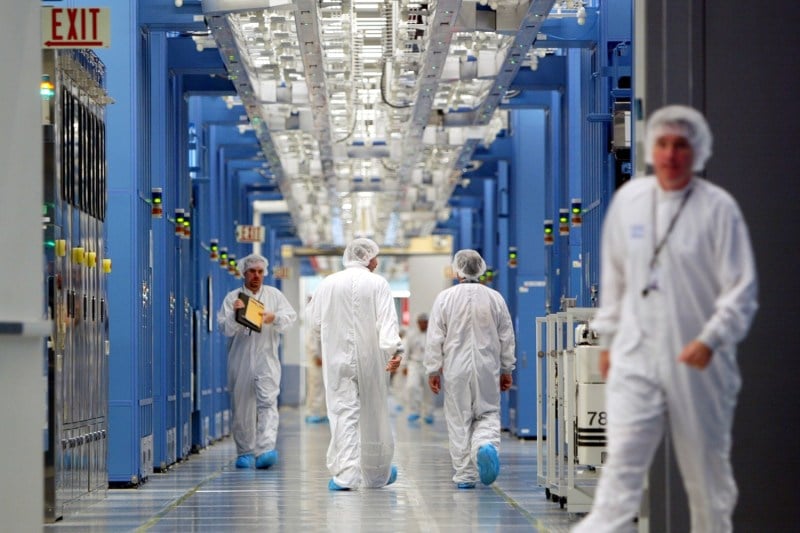Trump’s Russia Strategy Is All Carrots, No Stick

Trump’s Russia Strategy Is All Carrots, No Stick
“The Russians are obviously not responding to the current approach,” one expert said.
Russian President Vladimir Putin shakes hands with Steve Witkoff, an envoy of U.S. President Donald Trump, during a meeting in St. Petersburg on April 11. Gavriil Grigorov/AFP via Getty Images
U.S. President Donald Trump reentered the White House in January hoping to achieve a quick peace deal between Russia and Ukraine. More than 100 days into his second term, Trump is still pushing for an agreement—and he’s beginning to concede that ending the war in Ukraine is no easy task.
“Maybe it’s not possible,” Trump said of a Ukraine-Russia peace deal during an interview with Meet the Press that aired Sunday. But in an indication of Trump’s reluctance to give up just yet, the president added, “I think we have a very good chance of doing it.”
U.S. President Donald Trump reentered the White House in January hoping to achieve a quick peace deal between Russia and Ukraine. More than 100 days into his second term, Trump is still pushing for an agreement—and he’s beginning to concede that ending the war in Ukraine is no easy task.
“Maybe it’s not possible,” Trump said of a Ukraine-Russia peace deal during an interview with Meet the Press that aired Sunday. But in an indication of Trump’s reluctance to give up just yet, the president added, “I think we have a very good chance of doing it.”
Despite promising to end the fighting within 24 hours of taking office, Trump was always unlikely to see a deal reached quickly given the complex array of factors swirling around the war, former U.S. officials and experts say. And unless he’s willing to ramp up pressure on Moscow, the U.S. president is poised to continue falling short in this ambitious diplomatic endeavor.
“The Russians have no reason at this point to actually negotiate with faith because their aim is the political control of Ukraine, and they still don’t see a clear counterforce for that,” John Herbst, a former U.S. ambassador to Ukraine and Uzbekistan, told Foreign Policy.
Trump has put “pressure on the victim” to make concessions and “no pressure on the aggressor,” Herbst said.
“The bottom line is that this issue is very complicated, and there’s not a quick deal that leads to peace, that solves all the outstanding issues,” said Thomas Graham, who was the senior director for Russian affairs on the National Security Council staff under former President George W. Bush, in an interview with Foreign Policy.
It’s clear that Russia has been unwilling to make concessions from the beginning, Graham said, and changing that fact depends on the “dynamics on the ground” and the “political dynamics in Europe, Ukraine, and in the United States.”
The most that can be hoped for at this stage is “some sort of cease-fire along with what you might call a framework agreement that lays out the principles and parameters of a future settlement, which various parties would negotiate,” Graham said, but such discussions would “extend over a considerable period.”
The president’s handling of the peace process has frustrated supporters of Ukraine, some of whom have accused him of siding with Moscow. Trump has generally been much harder on Kyiv than Moscow, repeatedly and falsely blaming Ukraine for starting the war. He lambasted Ukrainian President Volodymyr Zelensky in a now-infamous Oval Office meeting in late February, and in the aftermath, he temporarily froze U.S. aid to Ukraine as well as intelligence sharing.
Meanwhile, Trump envoy Steve Witkoff, who has traveled to Moscow several times amid peace negotiations, has echoed the Kremlin’s talking points on the war and said in March that Russian President Vladimir Putin—widely considered one of the most repressive leaders on the planet—is not such a “bad guy.”
A peace proposal recently put forward by the Trump administration also offered extremely favorable terms to Russia: ruling out Ukraine ever joining NATO while offering U.S. recognition of Russia’s 2014 annexation of Crimea along with de facto recognition of Russian control over the four Ukrainian territories that it occupies (including partially)—Kherson, Luhansk, Donetsk, and Zaporizhzhia. Ukraine threw cold water on the proposal, which sparked Trump’s ire.
Though Russia has rejected the U.S. call for a 30-day unconditional cease-fire, which Ukraine agreed to in March and has continued to push for, Trump has still often pointed the finger at Kyiv over the lack of progress toward peace.
This approach, which falls in line with Trump’s long history of conciliatory behavior toward Putin, has so far not resulted in Russia taking any significant steps toward ending the war.
Russia recently announced a unilateral three-day cease-fire for this week, coinciding with its Victory Day commemorations in Moscow on May 9—a move that Zelensky rejected as a “theatrical show” while reiterating Kyiv’s offer for a 30-day truce. Retired Lt. Gen. Keith Kellogg, Trump’s special envoy to Ukraine, also dismissed Russia’s three-day cease-fire proposal as “absurd” and said it was not in line with the administration’s pursuit of a “permanent, comprehensive cease-fire.”
But experts say that unless Trump is willing to make life more difficult for Moscow, nothing will change.
“The Russians need carrots, like anyone in a negotiation, but so far they’ve gotten very few sticks,” Alina Polyakova, the president and CEO of the Center for European Policy Analysis, told Foreign Policy. “The Russians are actually accelerating their attacks in Ukraine. They’re killing innocent civilians. They’re killing women and children. All of this is just continuing in an incredibly brutal fashion. This seems to me the right moment to switch toward sticks.”
“The Russians are obviously not responding to the current approach,” Polyakova added, emphasizing that there’s still much that the United States can do militarily, economically, and politically to ramp up pressure on Moscow.
Trump’s former vice president, Mike Pence, issued similar criticism in an interview with CNN on Monday. Pence said that the “wavering” support that the Trump administration has displayed for Ukraine over the past few months has “only emboldened Russia.”
“If the last three years teaches us anything, it’s that Vladimir Putin doesn’t want peace; he wants Ukraine. And the fact that we are now [into] nearly two months of following a cease-fire agreement that Ukraine has agreed to and Russia continues to delay and give excuses, I think, confirms that point,” Pence said.
Pence said that Putin “only understands power,” adding that Washington needs to “make it clear” that it will “continue to lead the free world, to provide Ukraine with the military support they need to repel the Russian invasion and achieve a just and lasting peace.”
Continuing to supply weapons to Kyiv is crucial in terms of increasing the likelihood of extracting concessions from Moscow, Graham said, as it would convey to the Kremlin that “Ukraine is not going to break or collapse on the battlefield anytime in the near future.”
Western unity is also key in this process, Graham added, and “there needs to be a sense that the United States, our European allies, and Ukraine are on the same page—that we have a common idea of what we’re trying to achieve.”
Trump appears to be losing patience with Russia. In recent days, he has softened his tone toward Kyiv somewhat while offering rare criticism of Putin—particularly after a short but apparently impactful one-on-one meeting with Zelensky in Vatican City in late April.
After the meeting, Trump suggested that Putin may not want peace after all and might just be “tapping” him along, while raising the possibility of imposing additional economic penalties on Russia. And as Russia continues to pummel Ukraine with devastating attacks, the Trump administration has suggested in recent days that Washington could soon abandon the effort to achieve a peace deal altogether.
In a sign that even members of Trump’s own party want to push the process in a new direction, Republican Sen. Lindsey Graham—a key Trump ally in Congress—is garnering bipartisan support in the Senate for a bill that would impose “bone-crushing” new sanctions on Russia as well as tariffs on countries that purchase Russian oil, gas, and uranium.
“Attacking civilian populations, the arrogance that Russia has, that Putin has, it is taking a toll in the Senate,” the senator recently told the Wall Street Journal. “It’s clear to me—and I think it’s becoming clear to President Trump—that the Russians are playing games.”
But it remains unclear if Trump’s harsher rhetoric toward Moscow will last or translate into him taking a firmer approach with the Kremlin.
“Trump is mercurial,” said Herbst, the former ambassador. “This is where he seems to be today. Does this mean this will be where he is tomorrow? Hard to say. We do know, though, that the factors that have him where he is today are not going to change. Putin’s aim remains to have political control of Ukraine. That is inconsistent with Trump’s stated objective of achieving a durable peace.”
Herbst added that a “durable peace means that Ukraine survives as an independent, sovereign, secure, economically viable nation. That is certainly not on Putin’s agenda.”
Amid open questions about the White House’s commitment to the peace negotiations, a long-awaited minerals deal that Washington and Kyiv signed off on last week is being viewed with cautious optimism by those hoping to see a concrete shift in the administration’s approach.
“The minerals deal is the first truly positive development we’ve seen from Washington since Trump took office,” Herbst said.
The agreement, which grants the U.S. preferential access to new Ukrainian minerals deals and establishes a joint investment fund for the country’s reconstruction, does not offer the explicit security guarantees that Kyiv has called for. But it still ties Trump to Ukraine’s future, and it came with more forceful statements toward Russia from his administration.
“This agreement signals clearly to Russia that the Trump Administration is committed to a peace process centered on a free, sovereign, and prosperous Ukraine over the long term,” U.S. Treasury Scott Bessent said in a statement last week.
Under the terms of the agreement, future U.S. military assistance to Ukraine will be considered as capital contributions to the reconstruction fund. Trump has framed the deal as a way for the United States to recoup some of the billions in assistance that it’s already given to Ukraine.
This appears to be a moment in which the Trump administration “might be committing to a different approach,” Polyakova said, and “the signing of the minerals deal is absolutely a positive sign that the bilateral relationship” between Kyiv and Washington “may be getting back on track after a lot of turbulence.”
In another positive sign for Kyiv, it was also reported last week that the administration had taken steps toward its first arms sale to Ukraine—worth $50 million “or more”—since Trump’s inauguration.
“Now, Trump-approved weapons are going to start to flow. That’s an important step,” Herbst said. “If you really want to encourage Putin to embrace the reasonable proposal Trump put forward for a general cease-fire, send weapons to Ukraine so Putin knows he’s not going to be able to take any more territory. Now, $50 million doesn’t do that, but it is a warning to Moscow.”
If Russia continues to bomb Ukraine and stall negotiations, Herbst said, then “maybe Trump will turn the faucet on with greater volume on the military side.” And if the United States does end up walking away from the peace talks, as the administration has warned could soon happen, Herbst said “that’s actually not a bad thing at all, as long as our military support, both intel and weapons, continues” for Ukraine.
This post is part of FP’s ongoing coverage of the Trump administration. Follow along here.
John Haltiwanger is a reporter at Foreign Policy. X: @jchaltiwanger
More from Foreign Policy
-

Eight people dressed in camouflage military combat uniforms wade across a river, the water up to their waists. The soldiers carry large backpacks along with their rifles. Snowcapped mountains and a thick forest of evergreen trees loom in the distance. Get Ready for the Aleutian Island Crisis
As conflict heats up in the Arctic, foreign adversaries eye Alaskan territory.
-

U.S. President Donald Trump speaks to reporters before boarding Air Force One at Morristown Municipal Airport in Morristown, New Jersey, on April 27. Trump’s First 100 Days Reveal a ‘Strongman’s’ Unprecedented Weakness
No U.S. president has ever surrendered global power so quickly.
-

An elderly man and woman sit on the ground, the man on his knees as he sorts through something on the ground. Behind him are a rusted cart and bicycle in front of a paint-smeared concrete wall and a battered corrugated metal sign with the words USAID: From the American people” on it. What Trump’s New Budget Says About U.S. Foreign Policy
The president wants to significantly pull back on many of America’s traditional global engagements while spending more on the border and defense.
-

U.S. President Donald Trump listens to Secretary of State Marco Rubio at a cabinet meeting in the White House in Washington, D.C. Rubio’s Reorganization Plan Is a Wrecking Ball
The State Department revamp goes far beyond streamlining—it will devalue human rights and strip away critical expertise.












Join the Conversation
Commenting on this and other recent articles is just one benefit of a Foreign Policy subscription.
Already a subscriber?
.
Subscribe
Subscribe
View Comments
Join the Conversation
Join the conversation on this and other recent Foreign Policy articles when you subscribe now.
Subscribe
Subscribe
Not your account?
View Comments
Join the Conversation
Please follow our comment guidelines, stay on topic, and be civil, courteous, and respectful of others’ beliefs.
Change your username |
Log out
Change your username:
CANCEL
Confirm your username to get started.
The default username below has been generated using the first name and last initial on your FP subscriber account. Usernames may be updated at any time and must not contain inappropriate or offensive language.